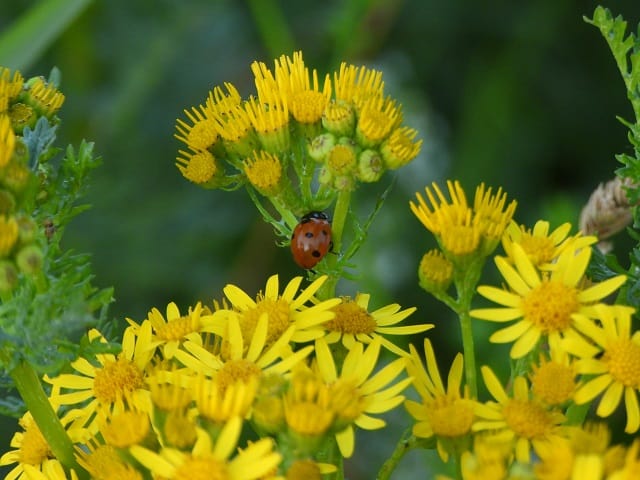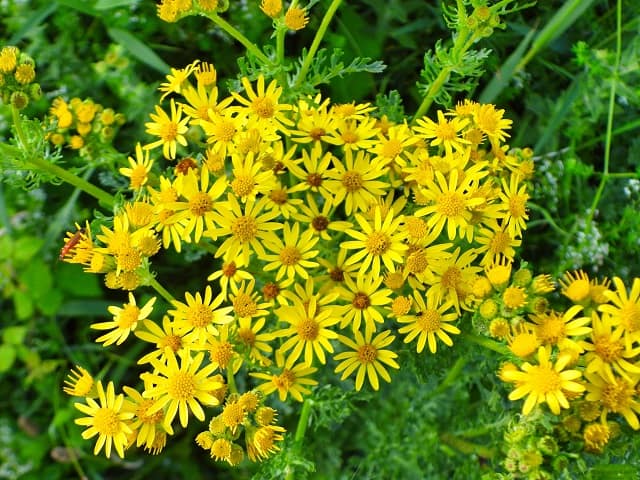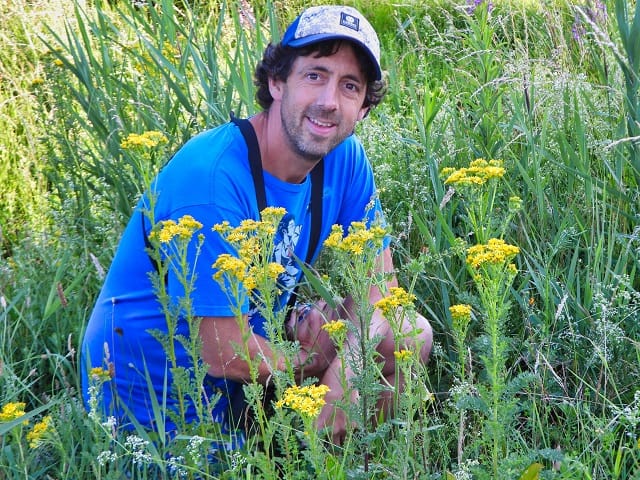
Standing about 3ft tall topped with clusters of bright yellow flowers you may see this plant popping up on the margins of fields and parks and quite often on our roadside verges.
Yellow Ragwort Is an incredible wildflower it’s one of the most sustaining hosts to insects that we have here in the UK. In all over 177 species of insect use ragwort as a source of nectar or pollen. To name a few, ragwort plays host to 7 species of beetle 7 species of micro moths, 30 species of solitary bees, 18 solitary wasps, 12 species of fly, 1 macro moth – the beautiful Cinnabar moth and even 50 insect parasites. But sadly, there is a lot of misinformation about this plant and that’s why I want to write about it.

Many people are keen to remove it from wherever it grows, there is a lot of hostility to this native plant that has been here since the last Ice Age. Grazing animals have evolved alongside it for thousands of years, but now people worry that it’s fatal to livestock if it’s eaten. Ragwort is indeed a poisonous plant, it contains pyrrolizidine alkaloids and when eaten in large quantities can lead to liver failure.

Many plants are poisonous if eaten in large quantities, even Daffodils, Tulips, Foxgloves, Rhododendrons and tomato plants. Every summer there is always scaremongering out there about ragwort. People are very quick to share it on social media. In reality this plant really is not a threat to livestock or horses. It’s only ever eaten in fields that are over-grazed and animals have no choice but to eat it, normally animals won’t touch it because they know it tastes bitter and disgusting.
In order for this plant to affect an animal, it would need to eat an excessive amount. Horses and cattle would need to eat between 5% and 25% of their body weight, so an average horse would need to eat over 50kg and eating even half that is extremely unlikely to ever happen. Another concern is that ragwort is poisonous to the touch but this is simply not true. The pyrrolizidine alkaloid that is present in 3% of all flowering plants cannot be absorbed through human skin.

Look out for this wildflower, appreciate it, grow it in your garden, I do! These plants are beautiful and a vital part of the ecosystem and we are wrong to remove them.
Thanet nature expert Nik Mitchell runs the Wildlife Conservation in Thanet page on facebook.
A response
In response to this column horse owner Melinda Winship writes:
Of 865 liver samples received by pathology services over a 5 year period, 72 (8.3%) were found to have evidence of megalocytosis; an indicator of ragwort poisoning. This actually translates to 57 samples a year. REMEMBER – this is going to be a gross underestimation of the number of cases as the majority are unlikely to have samples submitted for diagnosis. Some cases will be treated, some will die, some will be euthanised without a diagnosis.
In 2014 a BEVA survey reported that of 303 vets, 41% had seen at least one suspected case of ragwort poisoning in the past year. Each vet was seeing at least 2 cases per year. 49% died or were euthanised.
In a survey by the British Horse Society, Chairman is the amazing Martin Clunes & DEFRA in 2014, 19% of respondents knew of a horse that was suspected to have been poisoned by ragwort, with a definitive diagnosis in 21% of those cases. It was reported that 39% died or were euthanised.
Even a few mouthfuls of ragwort will cause some degree of IRREVERSIBLE liver damage. The more that is eaten, the more the damage. Damage accumulates over time! Moore RE, Knottenbelt D, Matthews JB, Beynon RJ, Whitfield PD. Biomarkers for ragwort poisoning in horses: identification of protein targets. BMC Vet Res. 2008 Aug 8;4:30.
As little ragwort as 1% of bodyweight can prove fatal over time – Fu, P. P., Q. Xia, G. Lin & M. W. Chou. 2004. Pyrrolizidine alkaloids – Genotoxicity, metabolism enzymes, metabolic activation, and mechanisms. Drug Metabolism Reviews 36: 1-55.
The risk from ragwort poisoning is not simply from plants grazed in paddocks but from ragwort contamination of feedstuffs such as hay or haylage.
Pyrrolizidine alkaloids (the toxic compounds in ragwort and other plants), are absorbed through the skin. The absorption is low, not non-existent. If you handle ragwort frequently without gloves you will develop liver damage.
So ragwort poisoning does occur in horses. It is relatively rare, but this is likely due to its removal from many areas horses and ponies graze.
“However, a justification or recommendation for relaxation in ragwort control would be a risky strategy as it is possible that the apparently low prevalence of ragwort toxicity in horses might be as a result of generally effective pasture management that, if relaxed, might lead to an increase in toxicity cases.” Andy Durham, BSc, BVSc, CertEP, DEIM, DipECEIM, MRCVS, Liphook Equine Hospital, Veterinary Record, June 13, 2015.
Postscript – “If you own horses, ponies or livestock you must not allow them to graze on land where you know ragwort is present” https://www.gov.uk/guidance/st

